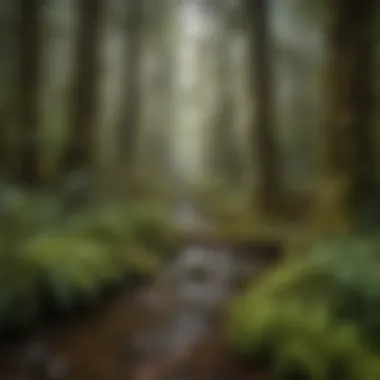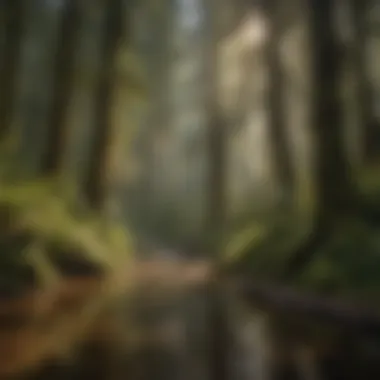Exploring Unique Lodging in Olympic Rainforest


Intro
The Olympic Rainforest, a UNESCO World Heritage Site, is more than just a picturesque destination. Its lush landscapes and vibrant ecosystems provide a backdrop for various unique lodging experiences that draw visitors seeking both adventure and serenity. This guide aims to unveil the diverse accommodations nestled within this verdant haven. Understanding the significance of these lodgings helps illuminate their connection to the surrounding environmental and cultural landscapes.
In the following sections, we will explore the ecological role of this rainforest, sustainable practices in forest use, and stewardship techniques vital for conservation efforts. Each facet contributes to the overall experience of visitors looking to immerse themselves in the beauty and complexity of the Olympic Rainforest.
Understanding Woodland Ecosystems
The Olympic Rainforest is characterized by its remarkable biodiversity and intricate ecosystem functions. To fully appreciate the lodgings available, it is essential to understand the foundations of these woodland ecosystems.
Importance of Biodiversity in Forests
Biodiversity refers to the variety of life within an ecosystem. In the Olympic Rainforest, this diversity is paramount. It includes thousands of plant and animal species, many of which are endemic to this area. The presence of diverse species helps maintain ecosystem balance, supports resilience against changes, and provides a myriad of resources for both wildlife and humans.
Role of Forests in Climate Regulation
Forests play a critical role in climate mitigation. They act as carbon sinks, absorbing carbon dioxide from the atmosphere and storing it in biomass. This function is particularly relevant in the context of climate change, making the preservation of forests vital. The Olympic Rainforest, due to its size and health, offers substantial potential for climate regulation, influencing regional weather patterns and contributing to global climate stabilization.
Sustainable Forestry Practices
Engaging with the Olympic Rainforest lodging options necessitates an understanding of sustainable practices employed in forest management.
Principles of Sustainable Forestry
Sustainable forestry aims to balance economic, social, and ecological considerations. This approach ensures that forest resources meet current needs without compromising future generations. Key principles include:
- Selective logging: Minimizing damage to the ecosystem while allowing for timber extraction.
- Forest restoration: Implementing practices to revive degraded areas, enhancing biodiversity.
- Community engagement: Involving local communities in decision-making processes to ensure their needs and knowledge are integrated into forest management.
Case Studies of Successful Implementations
Examining case studies where sustainable forestry practices have been implemented within the Olympic Rainforest demonstrates their viability. For instance, certain lodges collaborate with local environmental groups. These partnerships lead to reforestation efforts that not only bolster the ecosystem but also create educational opportunities for guests. Such initiatives help foster an appreciation for sustainable tourism and responsible forest management.
Woodland Stewardship Techniques
Effective woodland stewardship is crucial in fostering long-term health for the Olympic Rainforest and ensuring lodgings are part of a sustainable model.
Forest Management Plans
Forest management plans are essential for guiding the use and preservation of forest resources. These plans assess the land's ecological status, identify threats, and outline strategies to mitigate risks. Sound forest management methods consider the habitat needs of species living in the rainforest and account for local ecosystems.
Conservation Strategies
Conservation strategies focus on protecting biodiversity and critical habitats. They rely on various methods such as:
- Establishing protected areas to regulate access.
- Creating wildlife corridors that facilitate movement between habitats.
- Implementing community-based conservation programs that engage local stakeholders in safeguarding the environment.
Intro to Olympic Rainforest
Understanding the Olympic Rainforest is essential for anyone interested in lodging options within this unique biosphere. This section serves as an introduction, outlining both its ecological richness and significance. The Olympic Rainforest is not just a backdrop for lodging; it is a living ecosystem, home to diverse species and vital to climate regulation. As travelers seek immersive experiences, it is crucial that they appreciate the environment they are entering. The following details elaborate on the rainforest’s unique features and its essential role in our ecosystem.
Overview of the Olympic Rainforest
The Olympic Rainforest is part of the Olympic National Park in Washington State, recognized as a UNESCO World Heritage Site. This area is characterized by its lush vegetation and towering trees, some of which are thousands of years old. It is one of the largest temperate rainforests in the world, receiving substantial rainfall, which contributes to its dense forests and rich biodiversity.
The climate in this region is markedly different from the surrounding areas. While the Pacific Coast is known for its mild temperatures, the rainforest experiences cooler weather, creating a unique habitat for numerous plant and animal species. Visitors can expect stunning landscapes comprised of ancient trees, moss-covered grounds, and a variety of wildlife, making it a critical destination for nature enthusiasts and researchers alike.
Importance of Rainforests
Rainforests play a crucial role in maintaining the health of our planet. They act as a carbon sink, absorbing significant amounts of carbon dioxide, thus helping to mitigate climate change. The Olympic Rainforest specifically contributes to regional biodiversity, supporting unique flora and fauna found nowhere else. This ecological importance cannot be overstated.


The rainforest offers essential resources for both the environment and human populations. It provides habitats for countless species, many of which are endangered or vulnerable. Furthermore, it serves as a vital water source for many communities. Protecting these ecosystems is paramount, as they face threats from urban development, climate change, and pollution.
In summary, the Olympic Rainforest stands as a testament to nature’s splendor and resilience. Understanding its significance enhances our appreciation for the diverse lodging options surrounding it. Visitors to the area should be informed not just about where to stay, but also about the ecological context in which their lodging is situated.
Types of Lodging in the Olympic Rainforest
Lodging in the Olympic Rainforest is an essential aspect of a visitor's experience, as it provides unique opportunities for immersion in this rich ecosystem. Choosing the right type of accommodation enables guests to tailor their stay to their preferences, whether they seek comfort or adventure. Each option offers distinct insights into the character of the rainforest, allowing a deeper connection with nature. Moreover, the diverse lodging types cater to various budgets and lifestyles, enhancing the overall appeal of this destination.
Cabins and Cottages
Cabins and cottages are intimate and ideal for those wanting a cozy retreat surrounded by breathtaking nature. These structures often combine rustic charm with modern amenities, creating a comfortable atmosphere for visitors. Typically located in secluded areas, these lodgings allow guests to disconnect from urban life and enjoy the tranquility of the rainforest.
The benefits of staying in a cabin or cottage include:
- Proximity to nature trails
- Private outdoor space for wildlife observation
- A sense of privacy not found in larger establishments
- Opportunities to cook local ingredients, promoting a deeper culinary experience
Many cabins emphasize eco-friendliness in their construction and amenities. This commitment to sustainability aligns well with the principles of visiting this unique environment. Visitors often appreciate the design that maximizes natural light and minimizes energy consumption.
Lodges and Resorts
Lodges and resorts offer a more luxurious lodging experience within the Olympic Rainforest. These facilities usually provide a range of additional features such as fine dining, guided tours, and spa services. This level of comfort does not compromise the rainforest experience; instead, it enriches it by offering comprehensive services.
Key considerations when opting for lodges or resorts include:
- Access to organized activities, including guided hiking tours and educational workshops
- Enhanced amenities such as fitness centers and pools, giving space to unwind after a day's adventure
- Insurance of suitable dining options, showcasing regional ingredients
Visitors often choose lodges for social connectivity, as they may encounter fellow travelers while enjoying common areas or participating in communal activities. This creates an engaging atmosphere while still being surrounded by the lush rainforest backdrop.
Camping Options
Camping is a fantastic choice for outdoor enthusiasts looking to fully immerse themselves in the Olympic Rainforest. This option invites adventurers to experience the sights and sounds of nature up close. Campers can find designated campgrounds, offering a variety of amenities depending on the site.
Benefits of camping include:
- Lower costs compared to other types of lodging
- A unique experience of sleeping in the heart of the rainforest
- Opportunities for stargazing in a natural setting, away from city lights
In addition, many campgrounds emphasize eco-conscious practices, using sustainable resources and managing waste responsibly. For those comfortable with nature, camping provides an unparalleled connection with the environment, permitting a deeper understanding of local wildlife and plants.
Glamping Experiences
Glamping is a modern twist on camping, providing a more comfortable and luxurious experience within the Olympic Rainforest. These accommodations are designed to offer the essence of camping while ensuring that guests can enjoy numerous amenities.
The appeal of glamping lies in its blend of adventure and comfort. Here are some aspects to consider:
- Unique lodging types such as yurts or safari tents, often beautifully integrated into nature
- Access to premium bedding and private bathrooms, combining nature with luxury
- Opportunities to enjoy both relaxation and activities, including guided nature tours
Glamping often aligns with eco-friendly principles, using sustainable materials in construction and offering local culinary delights. This lodging type attracts visitors seeking a balance between adventure and comfort, presenting a unique experience in a majestic setting.
Ecological Considerations of Lodging
Understanding the ecological considerations of lodging is essential for preserving the delicate balance of the Olympic Rainforest. This rainforest is not just a spectacular collection of trees and wildlife; it is a critical ecosystem that supports biodiversity. Lodging options located within this area must prioritize sustainability and respect local environments. As we see more visitors come to this unique region, it is crucial to explore how accommodations impact the ecology and what practices can mitigate these effects.
Sustainable Building Practices
Sustainable building practices are vital for minimizing the environmental footprint of lodging in the Olympic Rainforest. This involves the use of local materials, renewable resources, and environmentally sensitive building techniques. Accommodations often incorporate wood sourced from sustainably managed forests, which reduces transportation emissions and supports responsible logging practices.
Features such as solar panels, rainwater harvesting systems, and energy-efficient lighting help reduce reliance on non-renewable energy sources. By prioritizing these practices, lodgings can lower their ecological impact while providing a comfortable experience for guests. It's imperative for travelers to seek out lodgings that adhere to these practices.
This also contributes to a greater awareness among visitors about the importance of conservation efforts in the rainforest. When lodges operate sustainably, they set a precedent that encourages environmental stewardship.
Impact on Local Ecosystems


Every lodging option in the Olympic Rainforest interacts with the local ecosystem. The impact can range from habitat disruption to increased waste generation. Lodges that are located near sensitive habitats must implement strict measures to protect wildlife. This includes managing waste properly and reducing light pollution, which can disrupt nocturnal species.
Keeping noise to a minimum is another key factor in protecting local ecosystems. Excessive noise can drive away wildlife and alter behavioral patterns. Lodging facilities must engage in ongoing dialogues with ecologists to assess their impact and develop strategies for improvement.
Furthermore, many lodges offer educational programs aimed at increasing awareness about local flora and fauna. This allows visitors to appreciate the environment while encouraging responsible behavior.
"Respecting local ecosystems is crucial for maintaining the biodiversity that the Olympic Rainforest sustains. Guided programs provide insights that turn casual visitors into informed stewards of nature."
In summary, the ecological considerations of lodging in the Olympic Rainforest extend far beyond comfort and luxury. They encompass a responsibility to ensure that these natural surroundings are preserved for future generations. By supporting sustainable practices and remaining mindful of the local ecosystem, travelers can enjoy their experience without compromising the environment.
Cultural Significance of the Olympic Rainforest
The Olympic Rainforest serves as a canvas rich in cultural history and significance. This rainforest is not just a breathtaking display of nature; it embodies the traditions, beliefs, and identities of the communities that inhabit or have historically inhabited its bounds. By understanding the cultural context, visitors can appreciate the depth and complexity of the area beyond its ecological importance. The blending of natural wonders and cultural narratives enhance the overall experience for those seeking to explore the Olympic Rainforest.
Indigenous Heritage
The Olympic Rainforest is steeped in the rich heritage of Indigenous peoples. Tribes such as the Makah, Quileute, and Hoh have thrived in the region for thousands of years. Their knowledge of the land, waterways, and ecosystem is invaluable. They understand the sustainable practices that allow them to coexist with nature. Indigenous cultures have maintained a close relationship with the forest, relying on its resources for food, shelter, and materials for crafting tools. This connection forms a profound part of their identity.
Visiting the region, travelers can engage with Indigenous history through various mediums. Traditional storytelling, art, and some guided tours offer insight into their lives intertwined with the environment. However, it is crucial to approach this subject with respect and awareness, acknowledging their past and present struggles.
Historical Context
The history of the Olympic Rainforest spans centuries, marked by both harmony and turmoil. Early explorations and colonization drastically changed the landscape and the lives of its inhabitants. The arrival of European settlers led to land disputes, cultural shifts, and the introduction of new economic models detrimental to Indigenous ways of life.
Nonetheless, there have been notable efforts to preserve this cultural heritage. Restoration programs, alongside advocacy for Indigenous rights, have gained momentum in recent decades. Many tribes are actively reclaiming their stories and land, ensuring that future generations connect with their roots.
"Understanding Indigenous history allows us to appreciate the forest not just as a resource but as a living testament to cultural resilience."
Today, the Olympic Rainforest stands not just as a national treasure but as a beacon of culture interwoven with nature. Visitors who explore the area are encouraged to reflect on the historical contexts and ongoing narratives that shape the rainforest. Recognizing these perspectives enhances the appreciation for the area's diverse offerings and promotes a responsible interaction with its resources.
Activities Accessible from Lodging Facilities
Understanding the activities available from various lodging facilities within the Olympic Rainforest enhances the overall travel experience. Engaging with these activities provides not only recreation but also deeper connections with the unique environment. Visitors can foster appreciation for the rainforest's biodiversity. Whether through hiking, wildlife observation, or educational programs, each option offers something distinct, appealing to a variety of interests.
Hiking and Nature Walks
Hiking and nature walks are integral to exploring the Olympic Rainforest. Numerous trails vary in difficulty, allowing both novice and experienced hikers to navigate the lush landscape. Trails like the Hoh Rain Forest Trail offer a glimpse into the unique flora, while more challenging routes lead to breathtaking vistas.
Some key points to consider:
- Trail Variety: Choose trails that match your skill level. Some trails are well-maintained, while others may require more experience.
- Guided Walks: Consider joining guided hikes, which provide insight into the ecology and cultural history of the area.
- Preparation: Always wear suitable footwear and pack water, especially during longer hikes. This ensures safety and comfort.
Incorporating hiking into your stay emphasizes physical health and encourages a deeper connection to the environment. Out here, being active fosters a realization of the rainforest's vastness and beauty.
Wildlife Observation
Wildlife observation presents another memorable activity for visitors. The Olympic Rainforest is home to diverse species, including elk, black bears, and numerous birds. Engaging in wildlife observation can be both exhilarating and educational. Observing wildlife in their natural habitats promotes respect for ecological systems.
Considerations for successful wildlife viewing include:
- Timing: Early mornings or late afternoons are often the best times to spot animals.
- Quiet Observation: Maintain silence to avoid startling wildlife, which enhances the chance of sightings.
- Binoculars and Cameras: These tools improve the experience, allowing for closer inspections without intruding on their space.
Participating in this activity contributes to a greater understanding of biodiversity in the rainforest ecosystem. It hones observational skills and nurtures a more profound appreciation for nature.
Educational Programs
Educational programs represent an enriching facet of what Olympic Rainforest lodging can offer. These programs are designed to raise awareness about ecology, conservation, and the region's cultural significance. They might include guided walks, workshops, or lectures desired by many visitors.
Here are some elements of educational programs:


- Workshops: Topics can range from forest ecology to photography, engaging different interests.
- Guest Speakers: Often, experts share insights about conservation efforts and ecological research, enriching visitor knowledge.
- Family-Friendly Activities: Educational outings geared for families can instill a love for the environment in younger generations.
Through these programs, visitors not only gain knowledge but also feel inspired to advocate for preservation. Understanding the complex interdependencies within the rainforest can lead to more conscientious choices when interacting with natural environments.
Emphasis on education can nurture a new generation of environmental stewards.
In summary, engaging in activities accessible from lodging facilities deepens the overall experience of the Olympic Rainforest. Hiking promotes physical activity and connection to the landscape. Wildlife observation encourages respect for the ecosystem. Educational programs foster a greater understanding of the rainforest’s complexities. Each of these elements enhances appreciation for this remarkable and diverse environment.
Planning Your Stay
Planning your stay in the Olympic Rainforest is crucial for maximizing your experience. This ecosystem is rich in biodiversity, but the region can also present unique challenges that require careful consideration. Understanding the various elements of your stay enhances the overall journey and ensures a fulfilling visit.
Best Time to Visit
Timing plays a pivotal role in enjoying the Olympic Rainforest. The climate here varies significantly based on the season. The summer months from June to September are generally ideal for exploration. During this period, the weather is relatively dry, allowing for more outdoor activities, including hiking and wildlife observation.
However, it’s worth noting that the rainforest can still experience rain even during summer.
Other times offer different experiences. In the fall, typically between October and November, visitors can witness vibrant autumn foliage, while winter may appeal to those interested in solitude and the atmospheric beauty of a quiet forest blanketed in snow. Spring brings a resurgence of wildlife, as well as blooming flowers.
Booking Lodging
Securing suitable lodging is another vital aspect of your planning. Options vary from rustic cabins to more luxurious lodges. It is common for popular lodgings to book up quickly, especially during peak seasons. To avoid disappointment, consider reserving your accommodations well in advance.
Take the time to explore the various lodging options available. Look for eco-friendly facilities that prioritize sustainability. Reading reviews from previous visitors can also provide deeper insight into what you can expect from your chosen lodging.
Packing Essentials
A well-thought-out packing list can significantly influence your comfort and enjoyment while exploring Olympic Rainforest. Essential items to consider include:
- Waterproof clothing: The rainforest’s weather can change unexpectedly, so packing a quality rain jacket is essential.
- Sturdy footwear: Prepare for diverse terrain with proper hiking shoes.
- Insect repellant: Protect yourself from insects common in lush environments.
- First-aid kit: A basic kit can handle minor injuries during outdoor activities.
- Binoculars: For birdwatching and viewing wildlife from a distance.
- Reusable water bottle: Staying hydrated is important, so bring a refillable bottle.
By taking these considerations into account, you will enhance the quality of your stay in the Olympic Rainforest, ensuring a memorable and enriching experience that aligns with your interests.
Reviews and Expectations
The section on reviews and expectations serves as a vital component in the exploration of lodging within the Olympic Rainforest. Understanding the experiences of previous visitors is essential for making informed decisions. Visitor feedback offers insights that are often missed in promotional materials. It provides a lens through which potential travelers can gauge whether a particular lodging aligns with their preferences and requirements.
Additionally, expectations regarding services can significantly impact a traveler’s experience. When individuals are aware of what to anticipate, they can better plan their stay. This preparation not only leads to a more enjoyable visit but also enhances safety and satisfaction.
Visitor Experiences
Many visitors share their stories about experiences in the Olympic Rainforest, and these narratives offer qualitative data that enhance comprehension of the environment. For instance, some have noted the serenity and the immersive nature of their lodgings.
Here are a few common themes found in visitor feedback:
- Natural Surroundings: Guests often emphasize the breathtaking scenery. Proximity to trails, rivers, and wildlife increases the appeal and satisfaction levels.
- Personal Touch: Lodges and cabins that provide personalized services or local knowledge are frequently praised. Travelers appreciate hosts willing to share stories about the area.
- Amenities Offered: Accommodations that offer eco-friendly amenities tend to receive positive attention. This can range from renewable energy sources to organic food options.
"Staying in a cabin by the river was transcendent. The sights and sounds of nature captivated me daily."
These experiences illustrate the potential for a profound connection with both nature and the local culture, further underscoring the importance of lodging decisions.
What to Expect from Services
When it comes to services, lodgings in the Olympic Rainforest can vary widely. However, there are some expectations that guests can generally rely upon:
- Cleanliness and Maintenance: Most reputable lodges prioritize cleanliness. Expect regular upkeep of facilities, as guest comfort relies heavily on hygiene.
- Knowledgeable Staff: Staff members are usually knowledgeable about the surrounding area. They can suggest trails, best wildlife viewing spots, or even cultural sites tied to local heritage.
- Outdoor Activities Arrangement: Many accommodations offer packages or guidance for outdoor activities. Services may include guided hikes, kayaking, or assistance with equipment rentals.
- Dining Options: Some lodges may provide dining facilities featuring local ingredients. Others might offer communal dining experiences, enhancing interaction among guests.
In sum, understanding reviews and service expectations contributes to a well-rounded experience in the Olympic Rainforest. Knowing what others have encountered helps travelers anticipate their own journey, ultimately leading to enhanced satisfaction and memories.
Culmination
The exploration of the Olympic Rainforest and its lodging options reveals not just a unique travel experience but also a significant ecological and cultural insight. This article emphasizes the importance of understanding the balance between enjoying nature and preserving it. The diverse forms of accommodation, ranging from rustic cabins to luxurious lodges, provide unique perspectives and opportunities for engagement with the natural surroundings.
Summarizing the Experience
In summary, experiencing the Olympic Rainforest involves more than just the superficial aspects of vacationing. Visitors are encouraged to embrace the following elements:
- Sustainability: Many lodges incorporate eco-friendly practices that minimize environmental impact. Understanding these can contribute to a responsible travel experience.
- Cultural Heritage: Engaging with the indigenous stories and practices of the local tribes enriches the stay, offering deeper connections with the land.
- Activities: From hiking to wildlife observation, each activity is designed to enhance connection to this unique ecosystem, catering to a range of interests from adventure to relaxation.







